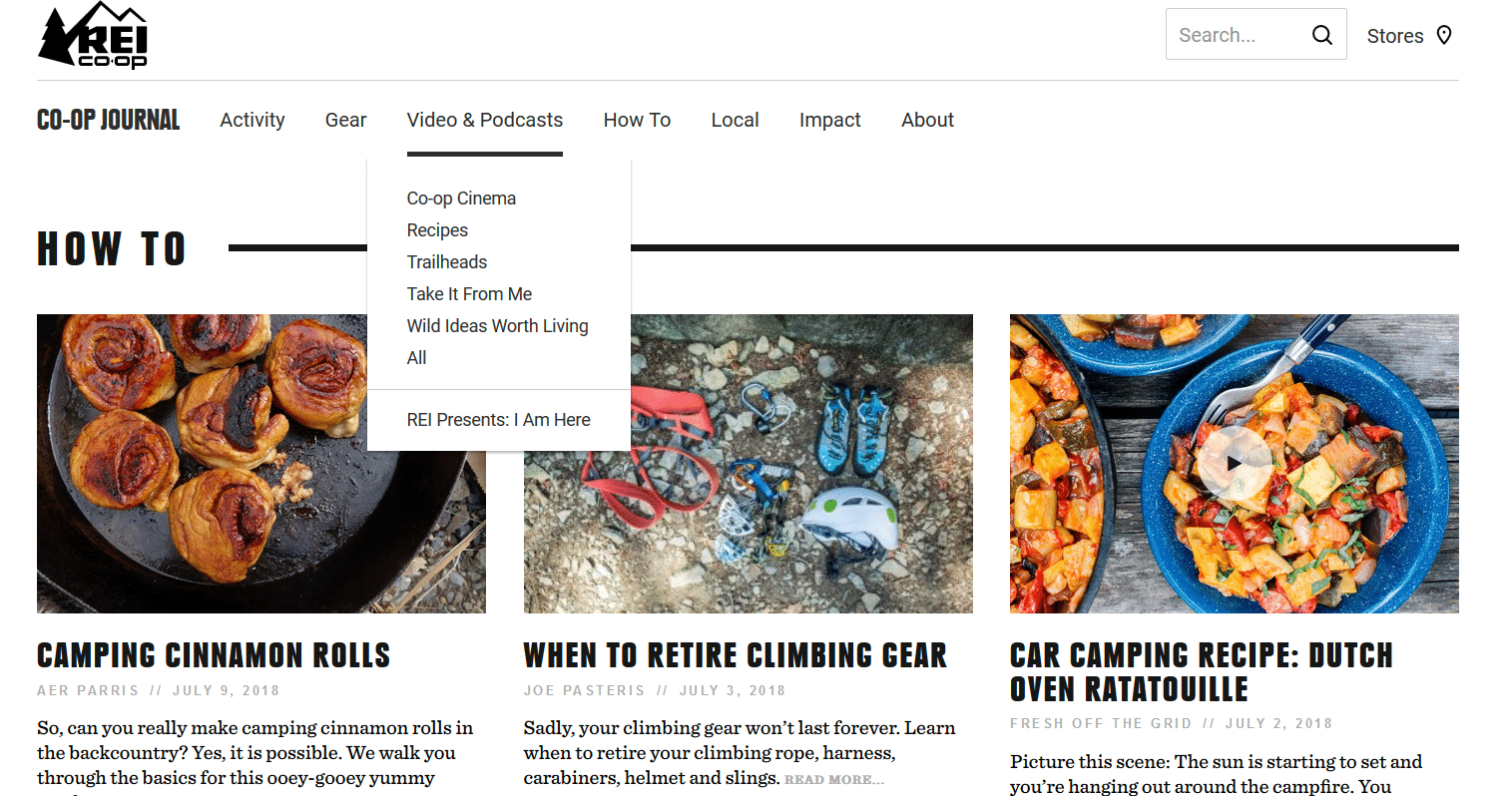![How to Build a Great Content Hub [With Examples]](https://marketinginsidergroup.com/wp-content/uploads/2023/09/iStock-1174494806.jpg)
How to Build a Great Content Hub [With Examples]
Marketers are producing more thought leadership content than ever. With all that great content comes a new challenge: what should a marketer do with it? Too often, well-intentioned marketing content ends up scattered all over the place: various website pages; random landing pages; blog posts; intranet sites; YouTube videos; and sometimes just an email to your sales channel.
What’s wrong with all these great content pieces floating around without much — if any — connectivity?
Your company might be incredibly smart and articulate about your customers’ or industry’s challenges. But if you allow your thought leadership on these topics to reside in random places, you’re missing an opportunity to display your cumulative knowledge on these important subjects. What’s the answer?
What Is A Content Hub?
A content hub is an online repository for your best content, where you can consolidate a point of view on important industry trends or offer materials and advice on best practices. Buyers are going to engage with multiple pieces of content before they engage with anyone from your company. A content hub will help you amass your published expertise, making it easier for potential customers to interact with multiple pieces on their topic of interest.
A content hub is also a brand-owned, digital destination, where brands act like publishers. This means:
- They publish content their audience wants
- They publish on a regular basis
- The content typically comes from a combination of authors
- There is often a variety of topics covered
- The content is typically more or less (and sometimes completely) non-promotional, but that is not always the case
- Content hubs can be more or less branded
- They can be “on domain” (the same as your company url) or branded separately
How to Build Your Own Content Marketing Hub
Many people confuse content with content marketing. But content is not content marketing. Content is everywhere. Content marketing, on the other hand, is about building and attracting an audience to the branded content destination you own to help you better reach, engage and convert new customers for your brand.
A successful content hub is one that your target audience will want go to regularly for information, insights and solutions to their toughest challenges and problems.
Once you’ve built your content destination, you can use social media to help distribute and amplify your content to drive more customers to your brand-owned platform.
So how do you go about building your content marketing hub? Here are 5 tips to help you get started:
1. Craft Your Content Marketing Mission Statement
Who is your target audience? What content topics are they most interested in? What value can you provide to your customers, knowing their needs, pain points, interests and business challenges?
You need to put your customers at the center when determining your content marketing mission statement, while making sure that it also supports your overall brand mission. This step is crucial as your content marketing mission statement is the foundation of your content marketing efforts.
2. Determine How Branded Your Content Destination Will Be
Will your content marketing hub be a part of your brand’s domain, like Adobe’s CMO.com or will it be on a completely unbranded site, like GE’s Txchnologist?
For an on-domain destination, you will want to make sure that your creative direction supports your corporate brand to some extent, so that the content experience is not completely off-brand and is consistent with other touch points and interactions with your brand.
For an off-domain destination, you have a bit more creative freedom, but ultimately it should support with establishing your content marketing hub as the go-to destination for your given topic and industry.
3. Think Like A Publisher
When you act as a publisher, it means creating and publishing the content your audience wants, but it also means so much more than that.
On any publisher site, you will find that they typically cover a variety of topics, with content coming from different authors. Publishers also make it easy for their readers to find the content they want to read, such as adding clear categories to show the topics their content destination covers.
You’ll also include a clear call-to-action or offer for your readers, and provide a way for them to reach your brand directly. And don’t forget to include social-sharing options to make it easy for your readers to help promote your content.
A great publisher is always thinking about growing their owned audience on their branded platform. Subscriptions are excellent indicators of your reach, engagement and conversion, as well as tracking what content resonates with your audience. So make sure you always include calls to subscribe to your updates, and use this data to help optimize your content marketing efforts.
4. Publish Regularly And Consistently
Readers visit and return to a publisher site for a reason. They know there is new content published regularly on the topics they’re interested in. So establish a regular content cadence and commit to maintaining it.
When starting out, try publishing at least once a week. If you’re covering two topics, you’ll want to publish at least twice a week. If you have the resources, I would even suggest publishing new content every day on the topics that will help drive the right audience to your content marketing hub.
5. Determine How You Measure Success
You can’t improve what you don’t measure. But one of the biggest challenges content marketers face is determining what to measure since there are so many metrics you can track.
My advice is to start small. Start measuring metrics like the number of new and returning visitors, page views, social shares, comments, average time spent on site, subscribers, and submission forms, or asset downloads if you offer ebooks and whitepapers, for example.
By tracking these areas, you can more effectively measure and optimize your content marketing efforts and demonstrate your ROI.
The Pros of Building a Content Hub on Your Website
There are major advantages to creating a content hub on your website. It’s easier, more streamlined and it’s connected to your products or services.
SEO
This advantage works both ways. The dynamic appeal of your hub’s media mix will boost your website’s SEO. At the same time, you won’t have to start from the ground up to generate traffic and optimize a separate site for your content hub because your website’s users can stay on your site to explore the hub.
Lower resource commitment
With limited resources, it’s a lot easier to build upon the website you already have than to create a standalone hub, promote it, optimize it, and make it into its own worthwhile online hot spot for your audience. This makes building onsite appealing to smaller businesses who don’t have the resources to create and cultivate a separate online entity.
Streamlined analytics
Your content hub will give you a lot of analytics as it tracks the way users interact with your hub’s content. When it’s an extension of your corporate website, this data can be streamlined with your other website data, giving you a clearer picture of your audience instead of having to differentiate between the two different sources of content data – and possibly, different buyer segments (unless that’s exactly what you are going for).
On-site hubs elevate the overall website, making it a greater source of value for your buyers and a more attractive destination. With smaller companies or if your hub is clearly aligned with the ideas, value propositions, and has the same SEO and target market you’re appealing to (and learning about through analytics), building your hub as just one more destination on your website makes a lot of sense.
REI’s content hub is an excellent example of a successful onsite hub.

When visitors click on the tab for REI’s CO-OP Journal, they stumble into a sea of well-organized content. The hub is user-friendly as it’s divided into multiple topics and subtopics – activities, gear, how-to’s, and local content. REI clearly positions themselves with their hub as an ultimate source of outdoor enthusiasts and adventurers. But it also uses the space to connect visitors with branded content that really drives home the REI story, which they may not have originally sought out, like their content surrounding sustainability and social responsibility and REI’s unique series – Take It From Me and Wild Ideas Worth Living.
REI’s content hub has enough complexity to deserve a microsite. But why take your audience to a different site when your products are a click away from inspiring content?
The Pros of Building a Standalone Content Hub
As practical as building your content hub on your site is, there are situations where it makes more sense to create a standalone content hub.
When your big company is also slow to adapt
Depending on your organizational structure, keeping your hub separate may be a smarter strategy. For example, in larger companies where there is a lot of red tape to make anything happen to the website, it may be wiser to let the content marketing team work at its pace to build an unfettered content hub.
When your hub itself is too big
One of the reasons to build a hub for your content in the first place is it improve the customer experience. Hub visitors can quickly access the information they want and can see, at a glance, related content they may be interested in. If your hub is loaded with different types of content, combined with different landing pages to pick up subscribers, event registrants, webinar sign-ups, podcast followers, and more, then your hub may need a home of its own. This allows you to create a better user experience and to better control the way visitors interact with your content.
To differentiate sales and content
When your content hub is all about establishing industry authority, it can be smart to make a standalone hub. This allows you to keep the sales pitch a mile away from the thought leadership articles, content created by your employees, curated content, and other content that is focused more on the message than the actual company.
To reach a new or specific audience
A separate microsite gives your content marketing the ability to take off in a new and exciting direction because it’s somewhat removed from the brand’s online corporate base. This also makes it a smart move if you want your hub to cater to a specific buyer segment.
The Hartford Financial Services has a dedicated content hub for targeting small business owners. SmallBiz is packed with helpful articles on topics small business owners and entrepreneurs would be interested in, as well as a SmallBiz podcast.

This how having a separate content resource center makes more sense. It appeals directly to a certain segment, creating a better experience for these viewers. This also makes it easier to generate leads as the entire hub directs viewers to one primary action – to sign up as a subscriber.
The Content Hub Location Checklist
When deciding where to build your content hub, you can use this checklist summarizing TriComB2B’s Chris Eifert’s advice to help narrow down what online space makes more sense for your brand and your content marketing strategy.
If your goal is…
- SEO, then using your corporate website is better
- Objectivity and authenticity, then a stand-alone hub is better
- To quickly create a site and you don’t have time for website bureaucracy, go for standalone
- The best user experience, then standalone is usually better, although a great user experience can work on the corporate website
- Lead generation, then standalone is usually more effective
Add to this list, these factors:
- Limited resources or small market presence, business website wins
- Planning on creating one or more hubs for different segments, opt for standalone.
Social Media Is Not Your Content Marketing Destination
According to the “Social Media Marketing Survey” from Clutch, 78% of enterprises surveyed say social media is the most important tactic for marketing success compared to other marketing strategies.
With shorter attention spans and changing consumer media consumption habits, many brands are realizing video’s effectiveness in engaging, educating and entertaining consumers. In fact, according to the Clutch survey, 23% of enterprises reported that video content outperforms images, offers and promotions, articles and infographics on social media.
So what’s the key takeaway for marketers here? Should you focus all your marketing efforts and resources on social media then? Will social media content will help you generate the most leads and revenue?
My perspective is that this is all wrong. Brands need to first develop their own digital content platforms, then look at social as a means of distribution.
Every day, brands are producing new content, everything from marketing content to sales, product, event and campaign content. It’s not enough to just create and share quality content anymore. If every marketer out there is pumping out valuable, relevant content just like you, how do you know if your target customers will actually engage with your content and not your competitors’ content?
The lifespan of social content is also extremely short. According to Spredfast’s in-depth analysis, the average median engagement of a tweet is around 30 minutes, and less than an hour for an Instagram post before they die.
Another study found that the half-life – which is the amount of time it takes to get half of your average engagement – of a Facebook post is about 3 hours. Keep in mind that your content won’t organically show up in the news feed of all your fans. With the constant changes to news and stream algorithms, you’re looking at less than 5% of your fans.
What these stats tell us is that marketers can’t rely solely on social media for their content marketing success. Social media is only a component of your overall marketing strategy, so it can’t be the only thing you’re doing.
And instead of trying to buy an audience on someone else’s platform, you want to build your own content destination to attract your target audience to this brand-owned platform.
What Is Your Favorite Content Marketing Hub?
One of the best way to show a business the importance of content marketing is to show them all the great examples of companies who are already doing it right.
I like to lead my own content marketing proposals with a few statements. Like these:
- Imagine you own the website for the generic category searches your customers use like L’Oreal’s Makeup.com
- Imagine you own the digital destination for your target persona like Adobe’s CMO.com
- Imagine your content marketing hub is the largest source of leads for your business like American Express Business Trends
I think it often helps businesses, who might need that little push into content marketing, to see what others are doing.
It starts with an understanding that marketing is not about selling, but about the conversation we have with our customers. It continues with investing in a brand-owned content marketing hub, because the difference between just content and content marketing is the destination.
Using this intent-based marketing and the proof that emotion beats promotion by more than two to one, any brand can become an amazing example of content marketing.
This list came from my constant desire to learn from others, to recognize those who are creating great content, to inspire those who are looking to build their own content marketing program and to help you see what approaches other companies are taking,
You will see a mix of B2B and Consumer brands. You will see a mix of on-domain and off-domain content hubs. You will see examples from companies large and small. You will see examples of brands that include some direct conversions and some that are only looking to build awareness.
Business / Technology Content Hubs
- Adobe CMO.com one of the earliest and best examples of lightly branded, off domain content hubs
- American Express Business Trends: “Insights, Inspirations and Connections To Grow Your Business” -1 of the earliest and most-cited example of content marketing
- Departures from American Express for their Platinum card members, run by Time Inc.
- Deluxe Small Business Revolution
- GE Reports
- GE Txchnologist
- Wistia Video Library
- BufferApp Blog
- Hubspot Blog “Your Daily Dose of Inbound” segmented by Marketing, Sales and Agency personas
- Salesforce Blog
- Moz Blog “Helping you level up your SEO and online marketing skills”
- LinkedIn’s Marketing Solutions Blog
- AT&T’s BusinessCircle “Where business owners share tech answers that matter”
- CapGemini Blogs
- HP Enterprise Community Blog and TechBeacon
- OpenView Venture Partners’ Labs another early example of content marketing for a small business
- Shutterstock Blog
- Google’s Think With Google
- SAS Blog
- Sprint’s Future of Business one of the winners of last year’s Content Marketing World awards
Retail and Fashion Content Hubs
- L’Oreal’s Makeup.com great example of a consumer brand “owning” the category
- The Birchbox Magazine and Men’s Guide
- Williams-Sonoma Taste beautifully designed site
- Harry’s Five O’Clock
- Warby Parker Blog
- Nasty Gal’s Nasty Galaxy
- LVMH’s Nowness
- West Elm’s Front + Main
- Tory Burch’s Tory Daily I like how this site humanizes the Tory brand
- The Etsy Blog
- Michael Kors Destination Kors
Consumer Brand Content Hubs
- Red Bull’s Red Bulletin a brand fully committed to acting like a publisher
- GoPro Video Channel great example of user-generated content
- P&G Everyday is another site that has been around almost from the beginning of modern content marketing
- Zillow Porchlight: “Always on. Guiding you home.” This site is so popular, they are selling ads
- Whole Food’s Whole Story
- Coke’s Coca-Cola Journey “Refreshing the world. One story at a time.”
- Electronic Art’s EA News Blog
- Microsoft’s Stories
- The Adidas Group Game Plan A “Personal insights into our business in sports.”
- Equinox Q Blog
- Uber’s Newsroom
- Rosetta Stone LinguaVore “A blog about learning language.”
- National Association of Realtor’s House Logic
- Honest.com’s Honestly Blog
Financial Services Content Hubs
- Betterment’s Resource Center “Information to help you lead a smarter financial life”
- The Hartford SmallBizAhead
- TD Ameritrade Tickertape “Pearls and insights for investors.”
- Fidelity MyMoney “Get in better financial shape today.”
- Bank of America BetterMoneyHabits
- First Round Capital Review
- Mint Life Blog
- Acorn’s new site Grow is looking awesome and one of my newest favorites in design
Healthcare Content Hubs
- Cleveland Clinic Health Essentials is one of the best examples on this list
- One Medical Blog: “You have one life. Make it count.”
- Excedrin.com
- Mayo Clinic’s Sharing offers personal stories of real people overcoming disease
Travel Content Hubs
- AirBnB City Guides
- Four Season’s Magazine
- Marriott’s Meetings Imagined and Travel Brilliantly
- WestJet Magazine
Other Industry Content Hubs
- Blackboard Blog (Education)
- WorldVision Blog (Non-Profit) “Building a better world for children.”
- US Government White House Blog (Government)
- British Gas The Source and Business Blogs (Energy)
Make Your Content Hub Strategic
When you have a solid content marketing strategy, your content hub is what can bring it all together for your audience. It also creates a central platform for sharing the strategy – inviting hub visitors to more than a blog post or a video but the whole pie, all in one, convenient location. It gives you more space to get your brand story clearly across than a single piece of content, and more opportunity to show your buyers just how useful your content – and by extension, your brand – can be in their lives.
What is your favorite? If you are interested in building your own content marketing hub, check out our Content Builder Services and let’s talk about how we can help!







I’d be remiss not to throw BlogMutt (www.blogmutt.com) in this group as well. I reached out to Michael (the author) and he encouraged me to share here.
We keep it super simple by providing wholly original blog content to companies and agencies that need blogs for their site or their clients’ sites. Our small team is extremely hands on, and as a result, we’re the largest blogging service company out there,
That’s it. I didn’t want to turn this into some hackey ad. But honestly, for companies that just keep negliecting their blog or need a service to fill in the cracks here and there, give us a look.
Thanks a lot Michael for sharing superb information.
For any content marketing beginner like me, this article is very much beneficial
I am reading so many articles from the past few days through which I can grow my content marketing business and today I have found one amazing article which will definitely help me for earning handsome amount of money…
Thank you once again
Regards
Jennifer
My pleasure Jennifer. Happy to help. I find examples are just a great way to teach and learn.